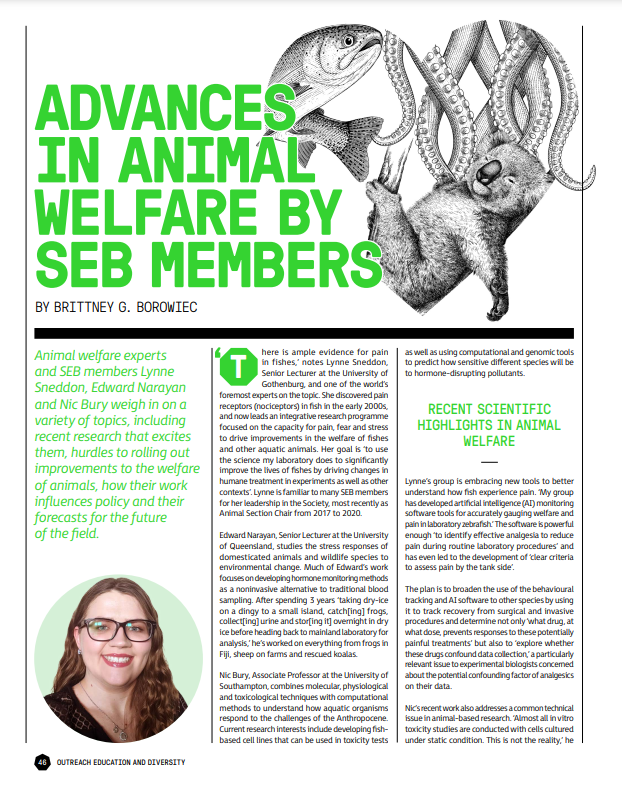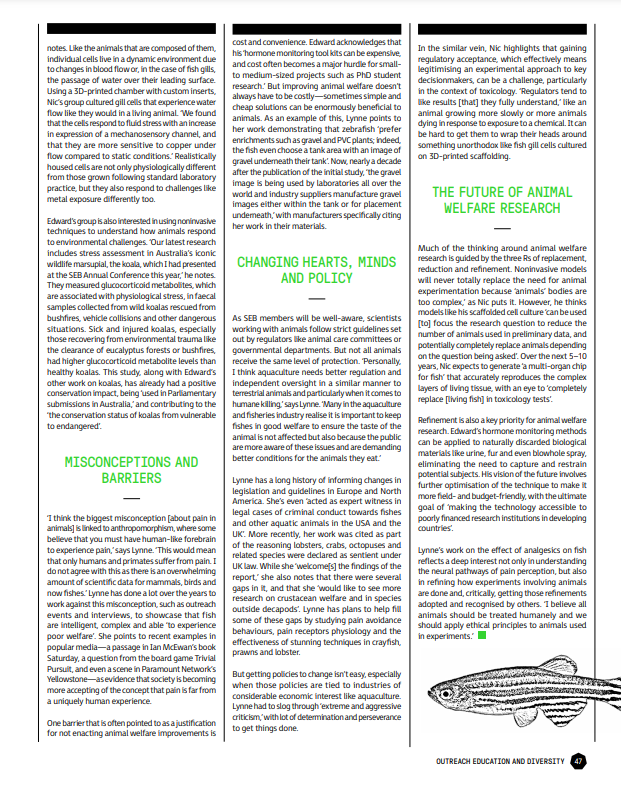Advances in animal welfare by SEB members
This article is featured in the SEB Autumn Magazine 2023 (page 46).
“There is ample evidence for pain in fishes,” notes Dr. Lynne Sneddon, Senior Lecturer at the University of Gothenburg, and one of the world’s foremost experts on the topic. She discovered pain receptors (nociceptors) in fish in the early 2000s, and now leads an integrative research program focused on the capacity for pain, fear, and stress to drive improvements in the welfare of fishes and other aquatic animals. Her goal is “to use the science my laboratory does to significantly improve the lives of fishes by driving changes in humane treatment in experiments as well as other contexts.” Dr. Sneddon is familiar to many SEB members for her leadership in the society, most recently as Animal section Chair from 2017 to 2020.
Dr. Edward Narayan, Senior Lecturer at the University of Queensland, studies the stress responses of domesticated animals and wildlife species to environmental change. Much of Dr. Narayan’s work focuses on developing hormone monitoring methods as a non-invasive alterative to traditional blood sampling. After spending three years “taking dry-ice on a dingy to a small island, ca[tching] frogs, collect[ing] urine and stor[ing it] overnight in dry ice before heading back to mainland laboratory for analysis,” he’s worked on everything from frogs in Fiji, sheep on farms, and rescued koalas.
Dr. Nic Bury, Associate Professor at the University of Southampton, combines molecular, physiological, and toxicological techniques with computational methods to understand how aquatic organisms respond to the challenges of the Anthropocene. Current research interests include developing fish-based cell lines that can be used to toxicity tests as well as using computational and genomic tools to predict how sensitive different species will be to hormone-disrupting pollutants.
Recent scientific highlights in animal welfare
Dr. Sneddon’s group is embracing new tools to better understand how fish experience pain. “My group has developed artificial intelligence [AI] monitoring software tools for accurately gauging welfare and pain in laboratory zebrafish.” The software is powerful enough “to identify effective analgesia to reduce pain during routine laboratory procedures” and has even led to the development of “clear criteria to assess pain by the tank side.”
The plan is to broaden the use of the behavioural tracking and AI software to other species by using it to track recovery from surgical and invasive procedures and determine not only “what drug, at what dose prevents responses to these potentially painful treatments” but also to “explore whether these drugs confound data collection,” a particularly relevant issue to experimental biologists concerned about the potential confounding factor of analgesics on their data.
Dr. Bury’s recent work also addresses a common technical issue in animal-based research. “Almost all in vitro toxicity studies are conduct with cells cultured under static condition. This is not the reality,” he notes. Like the animals that are composed of them, individual cells live in a dynamic environment due to changes in blood flow or, in the case of fish gills, the passage of water over their leading surface. Using a 3D printed chamber with custom inserts, Dr. Bury’s group cultured gill cells that experience water flow like they would in a living animal. “We found that the cells respond to fluid stress with an increase in expression of a mechanosensory channel and also are more sensitive to copper under flow compared to static conditions.” Not only are realistically housed cells physiologically different those grown following standard laboratory practice, but they respond to challenges like metal exposure differently too.
Dr. Narayan’s group is also interested in using non-invasive techniques to understand how animals respond to environmental challenges. “Our latest research includes stress assessment in Australia’s iconic wildlife marsupial, the koala, which I had presented at the SEB this year,” he notes. They measured glucocorticoid metabolites, which are associated with physiological stress, in fecal samples collect from wild koalas rescued from bushfires, vehicle collisions, and other dangerous situations. Sick and injured koalas, especially those recovering from environmental trauma like the clearance of Eucalyptus forests or bushfires, had higher glucocorticoid metabolite levels than healthy koalas. This study, along with Dr. Narayan’s other work on koalas, has already had a positive conservation impact, being “used in Parliamentary submissions in Australia,” and contributing to the “the conservation status of koalas from vulnerable to endangered.”
Misconceptions and barriers
“I think the biggest misconception [about pain in animals] is linked to anthropomorphism, where some believe that you must have human-like forebrain to experience pain,” says Dr. Sneddon. “This means only humans and primates suffer from pain. I do not agree with this as there is an overwhelming amount of scientific data for mammals, birds and now fishes.” Dr. Sneddon’s done a lot over the years to work against this misconception, such as outreach events and interviews, to showcase that fish are intelligent, complex, and able “to experience poor welfare.” She points to recent examples in popular media – a passage in Ian McEwan’s book Saturday, a question from the board game Trivial Pursuit, and even a scene in Paramount Network’s Yellowstone – as evidence that society is becoming more accepting of the concept that pain is far from a uniquely human experience.
One barrier that is often pointed to as a justification for not enacting animal welfare improvements is cost and convenience. Dr. Narayan acknowledges that his “hormone monitoring tool kits can be expensive, and cost often becomes a major hurdle for small- to medium-sized projects such as PhD student research.” But improving animal welfare doesn’t always have to be costly - sometimes simple and cheap solutions can be enormously beneficial to animals. As an example of this, Dr. Sneddon points to her work demonstrating that zebrafish “prefer enrichments such as gravel and PVC plants; indeed, the fish even choose a tank area with an image of gravel underneath their tank.” Now, nearly a decade after the publication of the initial study, “the gravel image is being used by laboratories all over the world and industry suppliers manufacture gravel images either within the tank or for placement underneath,” with manufacturers specifically citing her work in their materials.
Changing hearts, minds, and policy
As SEB members will be well-aware, scientists working with animals follow strict guidelines set out by regulators like animal care committees or governmental departments. But not all animals receive the same level of protection. “Personally, I think aquaculture needs better regulation and independent oversight in a similar manner to terrestrial animals and particularly when it comes to humane killing,” says Dr. Sneddon. “Many in the aquaculture and fisheries industry realise it is important to keep fishes in good welfare to ensure the taste of the animal is not affected but also because the public are more aware of these issues and are demanding better conditions for the animals they eat.”
Dr. Sneddon has a long history of informing changes in legislation and guidelines in Europe and North America. She’s even “acted as expert witness in legal cases of criminal conduct towards fishes and other aquatic animals in the USA and the UK.” More recently, her work was cited as part of the reasoning lobsters, crabs, octopuses, and related species were declared as sentient under UK law. While she “welcome[s] the findings of the report,” she also notes that there were several gaps in it, and that she “would like to see more research on crustacean welfare and in species outside decapods.” Dr. Sneddon’s has plans to help fill some of these gaps by studying pain avoidance behaviours, pain receptors physiology, and the effectiveness of stunning techniques in crayfish, prawns, and lobster.
But getting policies to change isn’t easy, especially when those policies are tied to industries of considerable economic interest like aquaculture. Dr. Sneddon had to slog through “extreme and aggressive criticism,” with lot of determination and perseverance to get things done.
In the similar vein, Dr. Bury highlights that gaining regulatory acceptance, which effectively means legitimizing an experimental approach to key decisionmakers can be a challenge, particularly in the context of toxicology. “Regulators tend to like results [that] they fully understand,” like an animal growing more slowly or more animals dying in response to exposure to a chemical. It can be hard to get them to wrap their heads around something unorthodox like fish gill cells cultured on 3D printed scaffolding.
The future of animal welfare research
Much of the thinking around animal welfare research is guided by the three Rs of replacement, reduction, and refinement. Non-invasive models will never totally replace the need for animal experimentation because “animals’ bodies are too complex,” as Dr. Bury puts it. However, he thinks models like his scaffolded cell culture “can be used for is to focus the research question to reduce the number of animals used in preliminary data, and potentially completely replace animals depending on the question being asked.” Over the next five to 10 years, Dr. Bury expects to generate “a multi-organ chip for fish” that accurately reproduces the complex layers of living tissue, with the eye to “completely replace [living fish] in toxicology tests.”
Refinement is also a key priority for animal welfare research. Dr. Narayan’s hormone monitoring methods can be applied to naturally discarded biological materials like urine, fur, and even blowhole spray, eliminating the need to capture and restrain potential subjects. His vision of the future involves further optimization of the technique to make it more field- and budget-friendly, with the ultimate goal of “making the technology accessible to poorly financed research institutions in developing countries.”
Dr. Sneddon’s work the effect of analgesics on fish reflects a deep interest not only in understanding the neural pathways of pain perception, but also in refining how experiments involving animals are done and, critically, getting those refinements adopted and recognized by others. “I believe all animals should be treated humanely and we should apply ethical principles to animals used in experiments.”


